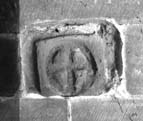Select a site alphabetically from the choices shown in the box below. Alternatively, browse sculptural examples using the Forward/Back buttons.
Chapters for this volume, along with copies of original in-text images, are available here.
Object type: Part of slab
Measurements: H. 25.5 cm (10 in); W. 34 cm (13.5 in); D. Built in
Stone type: Pale reddish brown (5R 6/2), medium- to coarse-grained (0.3 to 1.0 mm, but mostly medium-grained in the range 0.4 to 0.5 mm), sub-angular to sub-rounded, clast-supported, quartz sandstone. Small (0.3 to 1.0 mm) white mica flakes. Helsby Sandstone Formation?, Sherwood Sandstone Group, Triassic
Plate numbers in printed volume: Ill. 171
Corpus volume reference: Vol 9 p. 80
(There may be more views or larger images available for this item. Click on the thumbnail image to view.)
An encircled equal-armed cross of type A1, carved in relief, is set within a broad roll-moulding border, which survives on three sides of the stone.
The carving could represent the upper arm of a cross but is more likely to be the upper part of a slab; unfortunately it is not clear whether the encircled cross had an extended shaft. Previous discussion of this carving has associated the decoration with the circle-headed crosses of Chester and its region (Bu'lock 1972, 82) but, in the absence of both ornamented circle and protruding 'ears', the argument is not particularly convincing. Such simple forms, in which the cross-arms are straight sided and at right angles to each other, are difficult to date and, indeed, one suspects that they are not often recorded. Fisher (2001, 14, fig. 11) has illustrated several similar monuments from western Scotland which appear to be early medieval, whilst Ryder has claimed some English examples from Cumbria and Northumberland as twelfth century or later — a date which is also given to this carving by Baxter (Ryder 2003, fig. 13 (9, 10); id. 2005, 85, 165, 177; Baxter 2004c).



